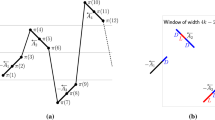Abstract
A large family of words must contain two words that are similar. We investigate several problems where the measure of similarity is the length of a common subsequence.
We construct a family of n 1/3 permutations on n letters, such that LCS of any two of them is only cn 1/3, improving a construction of Beame, Blais, and Huynh-Ngoc. We relate the problem of constructing many permutations with small LCS to the twin word problem of Axenovich, Person and Puzynina. In particular, we show that every word of length n over a k-letter alphabet contains two disjoint equal subsequences of length cnk -2/3. Connections to other extremal questions on common subsequences are exhibited.
Many problems are left open.
Similar content being viewed by others
References
M. Axenovich, Y. Person and S. Puzynina, A regularity lemma and twins in words, Journal of Combinatorial Theory. Series A 120 (2013), 733–743. arXiv:1204.2180.
R. C. Baker, G. Harman and J. Pintz, The difference between consecutive primes. II, Proceedings of the London Mathematical Society 83 (2001), 532–562.
P, Beame, E. Blaise and D.-T. Huynh-Ngoc, Longest common subsequences in sets of permutations, http://arxiv.org/pdf/0904.1615, April 2009.
P. Beame and D.-T. Huynh-Ngoc, On the value of multiple read/write streams for approximating frequency moments, ACM Transactions on Computation Theory 3 (2012), 6:1–6:22. http://eccc.hpi-web.de/report/2008/024/.
B. Bukh and J. Ma, Longest common subsequences in sets of words, SIAM Journal on Discrete Mathematics 28 (2014), 2042–2049. arXiv:1406.7017.
P. Erdős and G. Szekeres, A combinatorial problem in geometry, Compositio Mathematica 2 (1935), 463–470.
M. Kiwi, M. Loebl and J. Matoušek, Expected length of the longest common subsequence for large alphabets, Advances in Mathematics 197 (2005), 480–498. arXiv:math/0308234.
B. F. Logan and L. A. Shepp, A variational problem for random Young tableaux, Advances in Mathematics 26 (1977), 206–222.
A. M. Veršik and S. V. Kerov, Asymptotic behavior of the Plancherel measure of the symmetric group and the limit form of Young tableaux, Doklady Akademii Nauk SSSR 233 (1977), no. 6, 1024–1027.
Author information
Authors and Affiliations
Corresponding author
Rights and permissions
About this article
Cite this article
Bukh, B., Zhou, L. Twins in words and long common subsequences in permutations. Isr. J. Math. 213, 183–209 (2016). https://doi.org/10.1007/s11856-016-1323-8
Received:
Revised:
Published:
Issue Date:
DOI: https://doi.org/10.1007/s11856-016-1323-8




